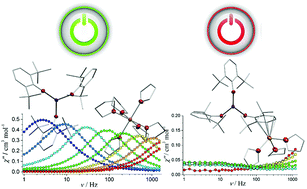On balancing the QTM and the direct relaxation processes in single-ion magnets – the importance of symmetry control†
Abstract
Two mononuclear trigonal-planar Co(II) complexes [Na(THF)6][Co(OAr)3] 1 and [(THF)3NaCo(OAr)3] 2 (OAr− = 2,6-di-tert-butylphenoxo, THF = tetrahydrofuran) with the same coordination number and donor atoms, as well as similar ligand fields except only for the local symmetry of Co(II), were isolated to test the symmetry-magnetization correlations. Although both complexes share similar magnetic anisotropy of the central Co(II) ions (D = −85.4 cm−1 for 1 and D = −80.6 cm−1 for 2), complex 1 exhibits single-ion magnet (SIM) behaviour while 2 displays no slow magnetic relaxation of magnetization with an applied magnetic field up to 7000 Oe. Such distinct performance is ascribed to the different effects of quantum tunneling of magnetization (QTM), which is further associated with the structural symmetry, namely, a strict C2v local symmetry for 1 and Cs local symmetry for 2. Theoretical calculations also indicate a larger value of transversal factors for 2, and hence a stronger QTM to be suppressed with a larger magnetic field at which the direct process is probably promoted, leading to the absence of SIM behavior of 2.



 Please wait while we load your content...
Please wait while we load your content...